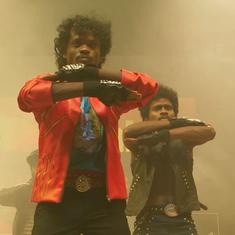I do not know if it was a sadness closed up within me or if it was something written in the book, but just nine pages before Son Of The Thundercloud, the new novel by Easterine Kire, came to an end, I found myself bawling. I closed the book; assured in the knowledge that no one was hearing me, I bawled my heart out; then resumed reading.
This part of the book is about a character being killed out of jealousy by someone he had trusted and thought of as his friend. A simple enough plot element, but when I look back at the suddenness with which I felt like crying, I am surprised. I am surprised by the fact that I cried, and I wonder if any other story or any other writer dealing with the same themes – of trust and betrayal – would have made me cry. Making a reader cry is not exactly an easy job for a writer. A reader needs to fully engage with the character they cry for, to cohabit that particular space that the character is living in, to adequately share the experience.
Normally, such an engagement might need words and pages. In Kire’s novel, a slim volume of barely 150 pages, though, there are no lengthy descriptions of the crises faced by the characters, who are described in only as many words as a reader needs to understand what is being said. Yet, the engagement I speak of is palpable. The magic in this novel kept me spellbound. Despite the sparseness of words and pages, not a single character seemed incomplete, and the scenes seemed to take place right before my eyes. No wonder I felt for the character who was killed and cried for him.
The difficulties of writing tales we have heard
I have read three books by Easterine Kire: her novels, Bitter Wormwood, When The River Sleeps, and this one. The first was a juxtaposition of Nagaland’s history and present – a political and social story rather than one based on the myths of Nagaland. That showed in the book’s girth. At nearly 300 pages, Bitter Wormwood was a novel-like novel. With When The River Sleeps, the novel which won The Hindu Prize 2015, Kire seemed to return entirely to her roots, telling stories that she must have heard from her family, her ancestors – stories that were told down the generations.
Kire belongs to the Angami community, which is indigenous to Nagaland. Like Kire, I too have an Adivasi background – I am a Santhal, from Jharkhand. Like Kire, I too have grown up with myths and legends that I heard from my family, whose members had heard those stories from our ancestors, dead and gone decades before I was even born. At times, I have tried writing those stories down in my own words in an attempt to develop them into longer works. I failed each time. The reason: I heard those stories, I did not read them.
The stories were rendered orally, and every person who knew a particular story had their own version to tell. And every version, irrespective of length or whether it was taken from real life, was either quite short or did not have a proper ending, an ending that could enhance it in terms of structure and narration. And so writing those stories was difficult unless I added my own imagination. But how much could I imagine? At one point, I feared that I might mar the original oral version if I added too much of my own to fit the demands of paper.
So, I know the limitations of basing a longer work on oral legends. But Kire seems to have mastered this art. She takes the traditional stories, folklore and myths of her community, and uses her imagination to create a work that is as magical in the written form as the original story, I am sure, is in the oral form. Her books based on these stories might not have too many words or pages or plot elements, but the description of a Naga landscape and village, of spirits and magical beings, of Naga customs and traditions, are so lively that the reader feels at home even during that brief journey.
When The River Sleeps is shorter and simpler than Bitter Wormwood, and Son Of The Thundercloud is far shorter and simpler than When The River Sleeps. The increasing simplicity of Kire’s books is their strength.

What the spirits do
In When The River Sleeps, the journey of the protagonist Vilie, who is in search of the “heart stone” from a river, comes alive as Kire brings in creatures from the spirit world, nasty spirits of river widows, and a forest of spectres – among other things – into the narration. Magic and simplicity travel along with Vilie in When The River Sleeps’.
Son of The Thundercloud is even simpler. Like When The River Sleeps, Son Of The Thundercloud too has a traveller. His name is Pele (short for Pelevotso), though he is not the hero. Pele here is the narrator-like character through whose eyes, and in the third person, we see the life of the eponymous Son of the Thundercloud.
The hero is a young boy named Rhalie (short for Rhalietuo), who was born after his mother, Mesanuo, is impregnated by a single drop of rain that fell on her body from a thundercloud. Mesanuo is the tiger-widow, whose husband and seven sons were killed by a tiger. This is no ordinary tiger, though, it is a spirit. Afraid of it, the people of the village in which Mesanuo lives – the Village of Weavers – have started offering sacrifices to the spirit tiger. But a prophecy has it that Mesanuo will be impregnated by a thundercloud and bear the Son of the Thundercloud, and this Son of the Thundercloud will slay the spirit tiger. Awaiting the fulfilment of the prophecy, Mesanuo has lived for more than three hundred years.
Pele is led to the Village of Weavers by Mesanuo’s sisters, Kethonuo and Siedze, each of them, like Mesanuo, having lived for over three hundred years.
The hugely intriguing plot – I was really drawn by the sisters having lived for more than three-hundred years – is held together by Kire’s terrific narration. She establishes the plot and moves forward with a pace that grabbed my attention. Concise and engrossing, every scene and chapter is only as long as it needs to be. There are no superfluous lines, nothing to hinder the reader’s attention.
I was already acquainted with the spirits and the things they are capable of doing from When The River Sleeps. Here, too, the spirits use a force of nature – heavy rains – to thwart the journey that Pele, Mesanuo and Rhalie make. But despite the return of the spirits, Son Of The Thundercloud does not seem repetitive. On the other hand, there are new magical elements: a famine that lasts four centuries, the earth shifting its position because of the movement of stars, and many others.
What’s also vital here is the coming together of modern life with the traditional. There are women who have lived for more than three centuries and are dissolving into their spirit forms, and yet the roof of their house has been built with tin.
The birth of Rhalie could find a parallel in the birth of Christ. This is a beautiful coming together of a Christian myth and Naga legends. Human nature, love, friendship, trust, fear, envy, and betrayal have been explored through the magical events in the novel. At one point, I even felt there’s a message about preservation of natural resources. And all of it has been written in Kire’s beautiful, almost touching prose. Sample these two passages:
“…I’m talking about the famine of stories and songs. They killed all the storytellers who tried to tell them about the Son of the Thundercloud. They killed hope…”
and
“Because the people sought to be free whenever they heard the stories. Free of fear, free of shame and constant desire. Without the stories, people believed they were destined to suffer, and allowed the dark ones to enslave their minds and fill them with fear and sorrow and despair until they died.”
For me, a novel that relates stories and storytellers to hope can never be wrong. I am in love with Son Of The Thundercloud.

Son Of The Thundercloud, Easterine Kire, Speaking Tiger Books.









